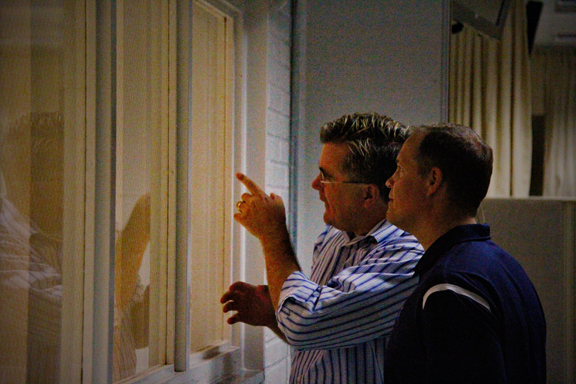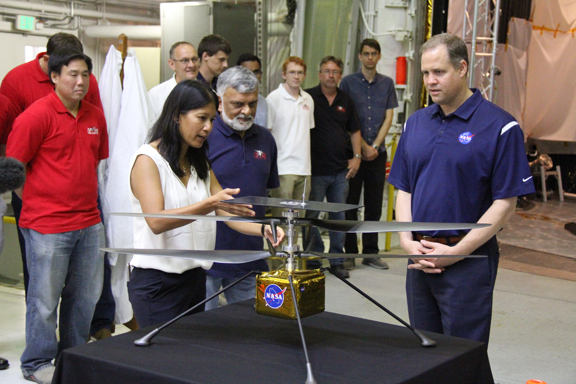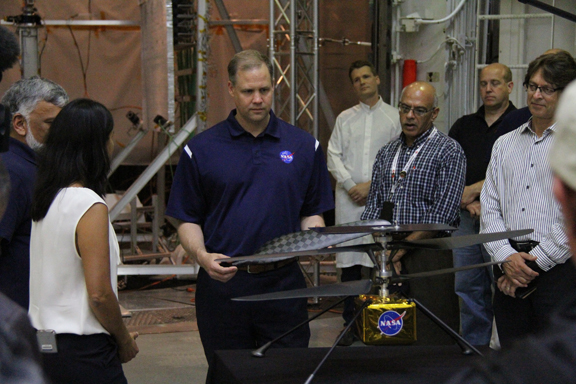NASA administrator sees what the future holds for Mars 2020 Mission

Dave Gruel (pointing) of JPL with NASA Administrator James “Jim” Bridenstine during Bridenstine’s visit to the JPL campus.
By Mary O’KEEFE
On Monday, Jet Propulsion Laboratory put its best red foot forward when it hosted NASA Administrator James “Jim” Bridenstine, escorting him through its Mars 2020 Mission lab.
Dave Gruel, ATLO (Assembly, Test and Launch Operations) manager for Mars 2020, showed the different phases of the Mars 2020 spacecraft and rover.
“All these different vehicles, we need them to successfully work in order for us to make it down to the surface [of Mars],” Gruel said.
Gruel went on to explain the many stages of the spacecraft and rover. The cruise stage gets the spacecraft and rover from Earth to Mars. The aero shell protects the crafts as they plunge through the Martian atmosphere. The descent stage, the “jet pack,” gets the rover safely down to the surface of Mars with the retro rocket firing. The bottom, he said, is “the star of the show.”
“This is the rover, which has all the instruments, [like] the cameras. This is what is actually going to return all the great science and start catching samples to bring back to Earth,” Gruel said.
Bridenstine listened intently to the engineers and scientists as they each went through their specific areas of responsibility for the Mars mission.
“With the discovery of water on Mars, is that changing where we are going?” Bridenstine asked.
“It doesn’t change this mission,” answered Katie Stack Morgan, deputy project scientist.
Mars 2020 is the next in an ambitious reach to the red planet. For 20 years missions built and managed by NASA/JPL have explored Mars. Each mission is built on discovery from prior missions that have flown, landed and rolled across the surface. Mars 2020 will have a rover, like other missions. Its mission is to seek signs of ancient life on Mars, collect and store a set of soil and rock samples that could be returned to Earth in the future and test new technology to benefit the future robotic and human exploration of Mars.
There are many instruments on the rover including an advanced camera system – a camera system that took a photo of Bridenstine on a Mars surface model.
One of the mission’s most unique aspects is a helicopter drone.
Helicopter project manager MiMi Aung explained the helicopter will fly in front of the rover and map the area. It will be able to go over terrain that is too difficult for the rover, and will land back on the rover.
“NASA has a proud history of firsts,” Bridenstine stated in a release. “The idea of a helicopter flying the skies of another planet is thrilling. The Mars helicopter holds much promise for our future science, discovery and exploration.”
Throughout the visit, Bridenstine made a point to praise the work that is being done at JPL and NASA. When asked about the recently announced Space Force, he said that it was important to remember that NASA is not about defense but about exploration and he wanted to keep that separate from the Space Force. He added that he felt this new section of the military, though, was necessary because of future threats.
He added it was important for NASA/JPL to continue to explore, not only the solar system, but Earth as well.


